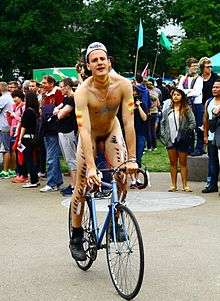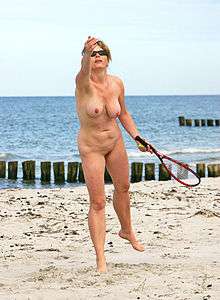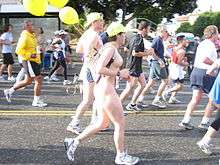Nudity in sport
- See also Nude recreation. See History of nudity for information about nudity in sports in historical times.

Nudity in sport is the custom of taking part in sporting activity while nude.
Being clothed is a matter of modesty and in some instances protection for the athlete. It was a norm in Ancient Greece for athletes to exercise and compete in the nude.[1] Today, it is a social custom in most parts of the world for athletes to wear some clothing, normally covering the athletes' crotch, and for women their breasts, but there are also some cultures in the tropics in which sports are played in the nude or partially nude.
History

It was a norm in Ancient Greece for athletes to exercise and compete in the nude.[1] In ancient Sparta, the Gymnopaedia was a yearly celebration during which naked youths displayed their athletic and martial skills through the medium of dancing. In antiquity even before the Classical era, e.g. on Minoan Crete, athletic exercise played an important part in daily life.
The Greek practice to compete and exercise was strongly inspired by their gods and heroes. For the gods and heroes nudity was a part of their identity and a way to display their physical energy and power which the athletes attempted to honour and emulate.[2]
Nudity in sport was first documented in the city-state of Sparta, during the late archaic period. The custom of exercising naked was closely associated with pedagogic pederasty and with the practice of anointing the body with olive oil to accentuate its beauty. Unlike other Greeks, Spartans also sometimes went naked casually, such as in the public city area. They were also the only city-state where women and girls also competed in the nude; the other states banned females both as participants and as spectators from any sporting event where male nudity was visible.
It spread to the whole of Greece, Greater Greece and even its furthest colonies, and the athletes from all its parts, coming together for the Olympic Games and the other Panhellenic Games, competed naked in almost all disciplines, with the exception of chariot races, although there are depictions of naked chariot racers too.[1]
It is believed to root in the religious notion that athletic excellence was an ‘aesthetical’ offering to the gods (nearly all games fitted in religious festivals), and indeed at many games it was the privilege of the winner to be represented naked as a votive statue offered in a temple, or even to be immortalized as a model for a god's statue. Performing in the nude certainly was also welcome as a measure to prevent foul play, which was punished publicly on the spot by the judges (often religious dignitaries) with a sound lashing, also endured in the bare.
Evidence of Greek nudity in sport comes from the numerous surviving depictions of athletes (sculpture, mosaics and vase paintings). Famous athletes were honored by a statue erected for their commemoration (see Milo of Croton). A few writers have insisted that the athletic nudity in Greek art is just an artistic convention, finding it unbelievable that anybody would have run naked. This view could be ascribed to Victorian morality applied anachronistically to ancient times. Other cultures in antiquity did not practice athletic nudity and condemned the Greek practice. Their rejection of naked sports was in turn condemned by the Greeks as a token of tyranny and political repression.
The word gymnasium (Latin; from Greek gymnasion, being derived from Greek gymnos, meaning "naked"), originally denoting a place for the intellectual, sensual, moral and physical education of young men as future soldiers and (certainly in democracies) citizens (compare ephebos), is another testimony of the nudity in physical exercises. In some countries including Germany the word is still used for secondary schools, traditionally for boys. The more recent form gym is an abbreviation of gymnasium.
The Romans, although they took over much of the Greek culture, had a somewhat different appreciation of nakedness (see Male nudity in ancient Rome). To appear nude in public was considered disgusting except in appropriate places and context: the public baths (originally open to both sexes) and even public latrines were as popular meeting places for all as the forum.
Athletic exercises by free citizens (no longer required to serve as soldiers since Marius' army reform) were partly replaced by gladiatorial games performed in amphitheatres. The gladiators were mainly recruited among slaves, war captives and death row convicts — the very lowest, who had no choice — but occasionally a free man chose this fast lane to fame and riches.
When fighting in the arena, against one another or against wild beasts, they would be armed with swords, shields etc., but would otherwise be partly or totally naked (see Gladiator for particulars).
- Gladiators were one of many features, especially religious, Rome inherited from its highly respected Etruscan neighbors. This ancient culture even depicts warriors fighting completely naked.
- When Christianity in the fourth century became the state religion, gladiatorial games were soon abandoned.
In Japan, female sumo wrestlers wrestled in the nude.[3] Today, females are not allowed to sumo wrestle, and the sport, practiced by men in ceremonial dress of loincloth size (mawashi) that exposes the buttocks like a jock strap, in general is considered sacred under Shintō.
In Western culture, nudity in sport in the modern context became popular only in the 19th century. Nudity in this context was most common in Germany and the Nordic countries, where "body culture" (also known as "Freikörperkultur", FKK) was very much revered. However, social nudism was outlawed for a time, and later rigidly controlled by Nazi ideologues in the 1930s and '40s ( - see "History" in the article on Naturism).
Recreational nude sport

Nudist clubs have traditionally offered members and guests of both sexes the opportunity to swim nude and many own or lease facilities that allow other sports to be played, including volleyball, tennis, badminton, bowling and the like. Typically these sports are played at a recreational level of intensity, and need not be particularly competitive.

Naturists/Nudists were early adopters of volleyball shortly after its invention in the late 19th century. Records of regular games in clubs can be found as early as the 1920s.[4][5] Given the outdoor nature of nudism/naturism a beach version of volleyball was naturally adopted. By the 1960s, a volleyball court could be found in almost all nudist/naturist clubs.[6]
Volleyball was perfect for naturism/nudism since most clubs were small and a volleyball court didn't require much space but involved many people. The game was also inclusive in that it supported varying levels of athleticism and did not require much equipment. But most importantly, it was ideal for nude play since there was no need for a team uniform or protective equipment.[7]
It is not uncommon for private clubs to give patrons opportunities for nude swimming, at times by holding male-only or female-only sessions.[8]
Organized events
Sport contests
One of the most popular events in naked sport is the international Alps Adria Meeting. In 2007, this annual contest will take place for the 35th time in the camping ground Kažela close to Medulin/Croatia (June, 7th to June, 10th 2007). About 150 participants are expected.
Another popular nudist sport event is the International Nudist Swimming Gala held by the International Naturist Federation in a different European city in early November every year.
The top event of naturist sport in Europe (and perhaps worldwide) is the famous International Naturist Sports Week in Hungarian naturist camping and recreational center of Sziksósfürdő near Szeged. Since 1989, the 7-day-event takes place every summer during the last week of July. Almost 40 different forms of sport are on the agenda of this event, with almost 400 participants from all over Europe.
Black's Beach in San Diego California hosts a yearly nude surf event that includes body boarding, body surfing and surfing. This event is open to everybody and is hosted by the blacks beach bares and the naturist society.
The "Nude Blacks" Rugby team of New Zealand competes in the nude.[9]
A large (over 70 teams) nude volleyball tournament has been held each fall since 1971 at White Thorn Lodge in western Pennsylvania[10] and several smaller tournaments occur each year throughout North America.[11]
Running and biking events

A nude run has taken place during the annual Roskilde Festival in Denmark since 1998. Another nude run called Carrera Nudista de Sopelana also takes place annually in summer in Sopelana (Bilbao/Spain) since 1999.[12] The World Naked Bike Ride is an international clothing-optional bike ride in which participants plan, meet and ride together en masse on human-powered transport (the vast majority on bicycles, and fewer on skateboards, roller blades, roller skates) to "protest oil dependency and celebrate the power and individuality of our bodies".[13]
On 21 June 2008, Sunnyrest Resort in Palmerton, Pennsylvania, hosted the first clothing-optional Mountain Bike Duathlon. Seventy athletes participated and competed during this professionally timed event. Most chose to race completely nude, except for footwear.
Nude running

Although already in the book The Zen of Running from 1974 it was recommended to run barefoot and "as undressed as possible" to get "well bathed by sun and air"[14] nude running has never gained wide acceptance.
Sports in tropical cultures
Many indigenous peoples in Africa and South America train and compete in sport competitions naked.[1] Nuba peoples in South Sudan and Xingu tribes in the Amazon basin region in Brazil, for example, wrestle naked, whereas Dinka, Surma and Mursi in South Sudan and Ethiopia, arrange stick fights.[1][15] Indian monks Digambara practice yoga naked (or sky-clad, as they prefer to call it).[1]
See also
- Gymnopaedia
- Issues in social nudity
- Public nudity
- Naturism
- List of places where social nudity is practised
- Nude recreation
- Nude hiking
- Strip games
- The Body Issue, ESPN magazines annual issue featuring nude photographs of athletes
Notes
- 1 2 3 4 5 6 "Nudity in sports throughout history". Active Naturists. Retrieved 1 August 2012.
- ↑ The Origin of Nudity in Greek Athletics; John Mouratidis; 1985; Journal of Sport History, Vol. 12, No. 3
- ↑ Chie Ikkai (2003), "Women's Sumo Wrestling in Japan", International Journal of Sport and Health Science, 1 (1): 178–181, doi:10.5432/ijshs.1.178
- ↑ Merrill, Mrs. Frances; Merrill, Mason (1931). Among the Nudists. A. A. Knopf. p. 188.
- ↑ Merrill, Frances (1932). Nudism Comes to America. New York: Alfred A. Knopf. pp. Illustration Plate following p.57.
- ↑ Weinberg, Martin (1967). "The Nudist Camp: Way of Life and Social Structure". Human Organization. 26 (3): 91–99. doi:10.17730/humo.26.3.t61k16213r005707. ISSN 0018-7259.
- ↑ "Volleyball at Bare Oaks Family Naturist Park". Bare Oaks Family Naturist Park. Retrieved 18 June 2013.
- ↑ VACHON, DANA (28 April 2005). "The Tao of Skinny-Dipping". nytimes.com. Retrieved 2016-04-05.
- ↑ "Google "nude blacks rugby"". Google.com. 21 July 2011. Retrieved 1 August 2012.
- ↑ Matz, Eddie (9 October 2009). "No shirts, no shorts... lots of service!". ESPN The Magazine. Retrieved 27 April 2013.
- ↑ "NudistVolleyball.com". Retrieved 1 May 2013.
- ↑ Castellano - Asociación de Naturistas Vascos
- ↑ Official World Naked Bike Ride global web site circa June 2004
- ↑ Rohé, Fred: The Zen of Running, New York and San Francisco 1974
- ↑ chan (2 October 2008). "Nuba wrestling". Soul Capoeira. Retrieved 15 September 2014.
References
- Crowther, Nigel B. (December 1980 – January 1981). "Nudity and Morality: Athletics in Italy". The Classical Journal. The Classical Association of the Middle West and South. 76 (2): 119–123. JSTOR 3297374.
- Giles, Geoffrey J. (1992). "Nudism of the Left and Right: Gymnastics in Weimar Germany". In Jordi Monés i Pere Solà. Education, physical activities and sport in a historical perspective = (Educació, activitats físiques i esport en una perspectiva històrica) : XIV ISCHE Conference 1992 : conference working papers. Barcelona: Institut d'Estudis Catalans. GGKEY:8TWTHDLFS2E.
- Mouratidis, John (1985). "The origin of nudity in Greek athletics" (PDF). Journal of Sport History. 12 (3): 213–232. Retrieved August 2014. Check date values in:
|access-date=(help) - Fiona Baker (13 September 2014). "Charting the rise of nude fitness". The Daily Telegraph. Retrieved 14 September 2014.
- "The Clothes Maketh the Man (Sweaty)". TenPlay. 15 September 2014. Retrieved 15 September 2014.
- Bond, Sarah (4 August 2016). "A Brief History Of Olympic Nudity From Ancient Greece To ESPN". forbes.com. Archived from the original on 2016-08-06.
External links
| Wikimedia Commons has media related to Nudity in sport. |
- World Naked Bike Ride (WNBR)
- International Naturist Sports Week - official website of Naturist beach & camping, Sziksósfürdö
- International Naturist Sports Week - documentation 1989 to 2004 (results of contests, description and galleries), official website
- 35th Alps Adria Meeting 2007
- Nudist Volleyball